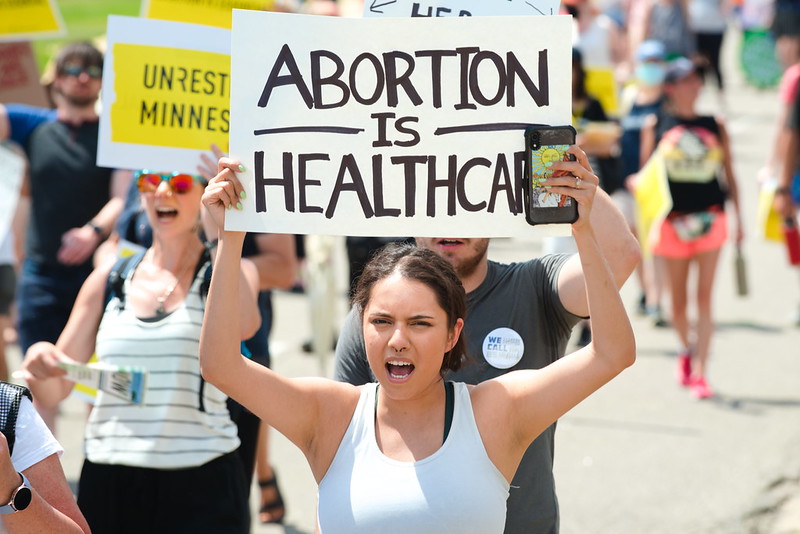“This association is robust—and it has nothing to do with politics,” said one co-author. “It’s all backed by the data.”
By Jessica Corbett. Published 12-28-2022 by Common Dreams.

Over 10,000 abortion rights protesters marched on the Minnesota Capitol to demand that abortion remain legal in Minnesota in July 2022 Photo: Fibonacci Blue/flickr/CC
With abortion currently inaccessible in over a quarter of U.S. states, peer-reviewed research published Wednesday highlights the impact of cutting off care, revealing that restricted access is linked to increased suicide risk in young women.
Published in the journal JAMA Psychiatry, the analysis of targeted regulation of abortion providers (TRAP) laws was conducted by four experts at the Children’s Hospital of Philadelphia (CHOP) and the University of Pennsylvania (Penn).
“Stress is a key contributor to mental health burden and a major driver of increased suicide risk,” said study co-author Ran Barzilay, a child-adolescent psychiatrist and neuroscientist at CHOP and Penn’s Perelman School of Medicine, in a statement.
“We found that this particular stressor—restriction to abortion—affects women of a specific age in a specific cause of death, which is suicide,” added Barzilay. “That’s the 10,000-foot view.”
While the study is based on state-level data from 1974 to 2016, it was unveiled at a time of heightened fear about abortion access—just six months after the U.S. Supreme Court reversed Roe v. Wade with Dobbs v. Jackson Women’s Health Organization.
Since that June 24 ruling, “trigger” bans have taken effect and anti-choice state legislators have escalated efforts to restrict abortion, blocking millions of people capable of becoming pregnant from seeking care close to home.
“Abortion is currently unavailable in 14 states, and courts have temporarily blocked enforcement of bans in eight others as of December 12, 2022,” according to a Guttmacher Institute review from last week.
During the years examined by the Penn-CHOP researchers, 21 states enforced at least one TRAP law.
“We constructed three indices that measure access to reproductive care by looking at the enforcement of state-level legislation,” explained lead author Jonathan Zandberg of Penn’s Wharton School. “Every time a state enforced a law that was related to reproductive care, we incorporated it into the index.”
After examining suicide rates before and after the laws took effect, and comparing them to rates elsewhere and broad trends, the researchers found that “comparatively, women who experienced the shock of this type of restrictive legislation had a significant increase in suicide rate,” Zandberg said.
The publication notes that during the period studied, annual rates of death by suicide were 1.4-25.6 per 100,000 women of reproductive age—the researchers focused on those 20-34—and 2.7-33.2 per 100,000 women of postreproductive age, or 45-64.
For reproductive-aged women, the average suicide death rate when no TRAP laws were enforced was 5.5 per 100,000, and enforcement of such a law was associated with a 5.81% higher annual rate—a trend that was not detected among older women.
A statement from the university points out that the researchers “examined another common cause of death, motor vehicle death rates, and saw no effect. Controlling for potential confounders like the economy and political climate did not change the results.”
In a difference-in-difference analysis of state-level data from 1974-2016, restrictions in access to reproductive care were associated with annual suicide rates among reproductive aged women, but not among women of postreproductive age. https://t.co/9KTRCxdAuo
— JAMA Psychiatry (@JAMAPsych) December 28, 2022
While acknowledging the limitations of their findings, the researchers also stressed how rigorious their methods were.
“This association is robust—and it has nothing to do with politics,” said Barzilay. “It’s all backed by the data.”
Co-author Rebecca Waller of Penn’s Department of Psychology stressed that “we’re looking at the connection between summary data about causes of death at the state level and policy and politics over many decades.”
“Yet, every death represents an individual moment of tragedy,” she said. “So, there’s clearly an awful lot more that we need to understand about what these findings mean for individual suicide risk.”
“Whatever your view is on all of this, it’s all over the news. It’s everywhere,” Waller added. “The women internalizing the stories they hear are the ones who these restrictions will affect the most.”
The new findings illustrate just one way abortion restrictions endanger the lives of people capable of pregnancy.
Research released earlier this month by the Commonwealth Fund shows that “compared to states where abortion is accessible, states that have banned, are planning to ban, or have otherwise restricted abortion have fewer maternity care providers; more maternity care ‘deserts’; higher rates of maternal mortality and infant death, especially among women of color; higher overall death rates for women of reproductive age; and greater racial inequities across their healthcare systems.”
That report argues that in partnership with residents and insurance and medical providers, state leaders can enhance the lives of patients by fighting for more and higher quality maternity care personnel and facilities as well as “by adopting the Affordable Care Act’s Medicaid eligibility expansion for low-income adults and extending Medicaid postpartum coverage to one year.”
“Increased federal funding for reproductive healthcare, family planning, maternity care, and care delivery system transformations also could mitigate the impact of the Dobbs decision and state abortion bans on people’s lives,” the publication adds. “State, congressional, and executive branch actions are all needed to protect the health of women and birthing people and ensure optimal and equitable outcomes for mothers and infants.”
The 988 Suicide & Crisis Lifeline—which offers 24/7, free, and confidential support—can be reached by calling or texting 988, or through chat at 988lifeline.org.
This work is licensed under Creative Commons (CC BY-NC-ND 3.0).

